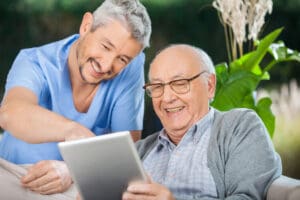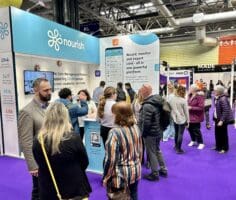Now working with over 500 care providers across the UK, we’ve been lucky to meet with so many fantastic organisations that are looking to go electronic with their care management.
Coming into 2019, we know that many more organisations are looking to make the same change, particularly with the latest NHS Long Term Plan’s focus on a better, more connected relationship with social care through the use of integrated technology. We thought we’d share with you the answers to the 5 top questions we’re asked as an digital care management provider:
-
How easy is it to train the care team to use digital?
-
What is the process of migrating from paper to a digital software?
-
Do you offer templates or are you customisable?
-
How secure is our data?
-
What makes you different from other providers?
1. How easy is it to train the care team to use digital?
Nourish was designed to be simple to learn.
When the development process started at Nourish, we made the conscious decision of giving extra weight to the design behind the solution rather than purely thinking of adding features. The thought behind this was simple but essential: if a system is too complex, it’ll demand too much time, cause frustration in the user and ultimately, not be used.
Our care management system was created to be used by the frontline care team – which is why we created the innovative concept of the Nourish Timeline. This is a daily log of care interactions for each person you support, which allows you to have better visibility over what care is being provided, what care needs an individual has and how they would like to be supported.
A very important aspect of this user focus has to do with the connection between care plans and the timeline. Instead of purely converting paper data to digital, Nourish links the relevant care plan information according to the care interaction; this means that care plans can be accessed at the point of care.
For example, you can learn an individual’s likes, dislikes and outcome plans for their nutrition when providing breakfast. Or an agency staff member can read someone’s shared personal biography before they start caring for them; not only allowing for a richer social experience but also ensuring they provide care in line with the individual’s preferences.
Frontline Care Teams are trained to use the timelines in small group sessions, which typically last up to an hour. This allows time for people to learn the 3-step process of using the timeline, understand where they can find important information and have a ‘test play’ to start building confidence. The basic, 3-step process of the timeline can be taught in 10-minutes for agency staff who are simply coming in to use the timeline for the day and record information. This ensures that there is minimal disruption to a busy care service day.
As with all new technology, confidence develops over time from consistent use. Recording care information electronically at the point of care becomes a natural aspect of the carer’s workload and they are supported with better access to important care information; notes are recorded to inform better care, rather than simply to be compliant.
“It’s better than sitting down with paperwork. I thought it would be hard, but it’s like using your own phone,” “It’s very easy. You find all the information that you want, it’s there. Now we have time to talk to residents” – comments from a recent CQC report.
2. What is the process of migrating from paper to a digital solution?
When presenting Nourish for the first time, training and the implementation process can be a key concern. Understandably, this is mostly because moving to an electronic system is a considerable change in an often otherwise paper-based environment. There is also concern regarding staff who may have little to no experience with digital technology – which is considered and prioritised in our training process.
The implementation process usually takes two months and goes as follows:
Agree & Build Documents
Firstly, you as the care provider decide whether you would like to use our standardised templates, which have been built specifically for different types of care, or whether you would like to continue with your current documents and templates.
Should you choose to use your own, we will ask that you send us blank copies of all of your documentation – forms, assessments, care plans – and we will build these into the platform so they’re ready to use on day one.
Training
Secondly, is training for you and your team. We break down our training into two separate sections; the timeline training and the care plan training.
Timeline training comes first and this is where you get 80% of the return for 20% of the effort. In small group sessions, we teach your team how to use and get the most from the timelines, where you will record your daily notes.
Care plan training takes place four to six weeks later, to provide you with the opportunity to familiarise and gain confidence in using the timelines and ask any questions that arise. The care plan training is a more in-depth training that is provided to key members of your team who will be involved in care plan writing and reviews and the administration and upkeep of the system.
From this point onwards you will be able to fully switch to digital, should that suit your service. Some care providers choose to gradually move from paper to digital and we are happy to support whichever approach you choose.
Continued Support & Monitoring
We continuously monitor your usage of the system remotely to keep an eye on progress, but also to ensure you’re using the system to the best of its ability. We are always releasing new client-led developments and we want to make sure you’re aware of, and using, these new features.
You’ll have ongoing access to our awesome support team and you can drop us a message on the Nourish Support at any time, should you have any questions. We focus on continuous improvement, to stay fresh and dynamic, so we believe that going digital is not the end goal, but an ongoing process for which we are here to support.
The time it takes to move information can vary greatly depending on a number of different factors. For instance, the amount of information you choose to move over, how far back you move information over and who you assign to be involved in the transition.
We have worked with a number of care organisations who approach this is in different ways, so we would be more than happy to discuss the different options with you, to find the approach that suits your environment best.
3. Do you offer your own templates, or can you customise the format to our practices?
The simple answer is that we offer both.
One of our key focus points is the ability to be flexible and customisable. No individuals or care providers are the same and that means our software needs to be able to support a variety of different ways of working.
We can and do offer templates based on best practice, past research and experience and direction from industry consultants. These can support care organisations who are looking for a starting template or a standard template they can build on.
On the other side, care providers can build their own templates and care plan structures into Nourish – from the beginning, it has been designed to support how you already work, rather than forcing you to work in a different way.
Whichever approach you take, Nourish still offers in-depth granularity on individualising the recording of care. For example, you can personalise at group level (e.g. policies and procedures), at service or home level (e.g. a community service within a group of care homes), at the individual level (e.g. unique care plan format for someone in palliative care), daily level (e.g. Maggie prefers to only have showers on Mondays, Wednesdays, and Fridays), and even interaction level (e.g. each resident can have the interaction ‘Breakfast’, but Frank prefers his toast with extra butter).
There is a reason CQC doesn’t enforce specific templates, but rather focuses on the KLOE approach; care needs to be evidenced and documented, but it also needs to be unique to each organisation, the type of care they provide and the person they’re caring for. We work hard to make sure that can all be supported.
4. How secure is my data with you?
As a data handler of important, personal and medical records, our security has always been a critical focus. We have been registered with the ICO since 2014 and are fully GDPR compliant. All of our servers, including backups, are physically located in the UK and your data is encrypted both in transit and at rest in our AWS data servers. In 2018, we also received the Cyber Essentials accreditation.
One of the main advantages of going digital is the instant access to all of your data, simultaneously by different users. At the device level, we use Device Management to manage remote access for different roles. We also have access permissions which allows you as a care organisation to control who has access to what information. Through the Device Management System, we are able to geolocate individual devices, lock down handsets and remotely control and update them.
5. What makes you different from other providers?
The care providers we work with understand that first and foremost we’re not a ‘tech’ company, but rather a company that understands how technology can be used to enhance the provision of care teams and empower care teams with better access to information, better use of information and less time on paperwork.
Our key differentiator lies in three areas: adaptability, ease-of-use and exceptional ongoing support.
Adaptability
As above, Nourish was designed to be flexible to how different people work. Each care provider we work with approaches their care records slightly differently, and we ensure we facilitate that. Whether that be different uses of terminology, different forms, assessments or specific care plan structures; all of these can be created in Nourish to reflect how your team or organisation works.
Ease-of-use
By focusing on user experience and design, we have created a system that is simple to use – but still has the incredible complexity and intelligence it needs to work in such a diverse sector. We strongly believe that technology should be enjoyable to use – we want care teams to want to use Nourish, so that they record better, more rich information and this leads to a better experience of care for the individual. We focus on electronic care planning and care recording and we’re experts in what we do – everything is done in house, from design to development all the way to training and support, so we always have the expertise on hand to answer questions or resolve new challenges.
Support
We truly pride ourselves on our ongoing support and you really don’t have to take our word for it – check out some of the incredible feedback our support team had at the end of last year. Our approach to support is: “To provide our clients with a consistently premium experience. We want our clients to enjoy talking with us and to feel that their issue has been respected, acknowledged and dealt with promptly. At all times, we have to be patient, understanding and explain in as much detail as is needed.”
I hope these answers are helpful to you in making the decision to move to electronic care planning and if you have any other questions, book a personalised demo with our team today.
—–*—–
You may also be interested in reading:





